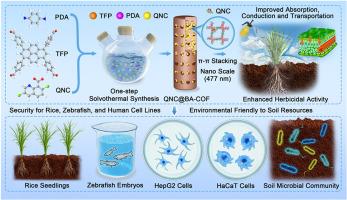Fabrication of a nano-herbicide QNC@BA-COF with high control efficiency and reduced side effects
引用次数: 0
Abstract
The low efficiency of herbicide formulations poses environmental risks during spraying. Nano-based encapsulation technology can enhance utilization efficiency for sustainable agriculture. Covalent organic frameworks (COFs) serve as potential nanocarriers for pesticide loading, although their poor solubility limits the loading capacity. Herein, the insoluble herbicide quinclorac (QNC) was loaded into a pyrene-based COF (BA-COF) via one-step solvothermal synthesis to fabricate a nanoherbicide formulation (QNC@BA-COF). Molecular dynamics simulations showed that QNC molecules were loaded into the BA-COF via π-π stacking interactions. QNC@BA-COF was 44.7 % more effective against barnyard grass (Echinochloa crus-galli) than commercial QNC wettable powder (QNC WP) at 100 g ai/hm2, with minimal adverse effects on rice (Oryza sativa) seedlings and reduced toxicity toward zebrafish (Danio rerio), and human cells. Additionally, QNC@BA-COF-treated soil contained more beneficial microbes than those treated with QNC. This study presents a novel method for loading insoluble agrochemicals and a promising nanoherbicide formulation for sustainable agriculture.

一种控制效率高、副作用小的纳米除草剂QNC@BA-COF的制备
除草剂配方效率低,在喷洒过程中存在环境风险。纳米封装技术可以提高可持续农业的利用效率。共价有机框架(COFs)是潜在的农药负载纳米载体,但其溶解度差限制了其负载能力。本文采用一步溶剂热合成的方法,将不溶性除草剂二氯丙酸(QNC)负载到芘基COF (BA-COF)中,制备了纳米除草剂配方(QNC@BA-COF)。分子动力学模拟表明,QNC分子通过π-π堆叠相互作用被加载到BA-COF中。QNC@BA-COF对稗草(Echinochloa crus-galli)的防治效果比100 g /hm2的QNC可湿性粉剂(QNC WP)高44.7%,对水稻(Oryza sativa)幼苗的不良影响最小,对斑马鱼(Danio rerio)和人体细胞的毒性降低。此外,QNC@BA-COF-treated土壤比QNC处理的土壤含有更多的有益微生物。本研究提出了一种装载不溶性农药的新方法和一种有前途的可持续农业纳米除草剂配方。
本文章由计算机程序翻译,如有差异,请以英文原文为准。
求助全文
约1分钟内获得全文
求助全文

 求助内容:
求助内容: 应助结果提醒方式:
应助结果提醒方式:


